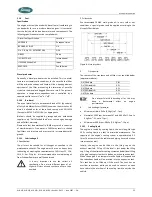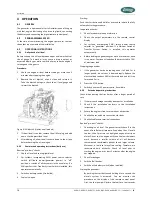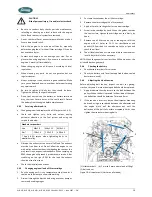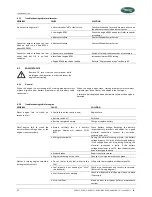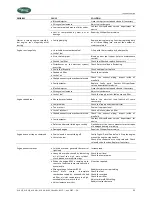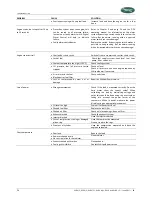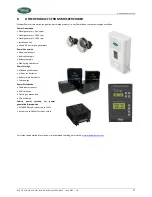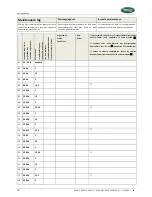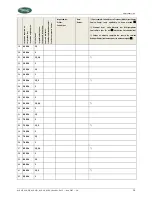
TROUBLESHOOTING
22
W-GV/2, W-GV/3, W-GV/3+, W-GV 8, W-GV 10 and W-GV 15 — June 2017 — EN
6.2.1
Troubleshooting table for alternator
PROBLEM
CAUSE
SOLUTION
No output (voltage) at all
Circuit breaker "off" or faulty fuse
Check switches and fuses and measure directly on
the alternator to exclude external causes.
Low engine RPM
Check the engine RPM and adjust (refer to special
procedures
Alternator failure
Contact WhisperPower Service
Genverter output voltage too low
when no load is on it and RPM is
above 2500 RPM
Alternator failure
Contact WhisperPower Service
Genverter output voltage too low
under load, but OK in no load
condition
Genverter is overloaded
Switch off a load; reduce number of consumers
Insufficient engine RPM
Increase minimum RPM setting
Engine RPM drops when loaded
Refer to “Engine speed drops” section in 6.2
6.2
ENGINE FAULTS
Remove 3 A fuse from the control panel while
working on the Genverter in order to prevent the
engine from starting.
6.2.1
General
When the engine is not cranking well, starting problems almost
always originate from battery problems or poor battery cable
connections.
When the engine does crank, starting problems almost always
originate from lack of fuel or air bubbles in the fuel pipes.
A failure code is displayed when a hardware failure at the engine is
detected.
6.2.2
Troubleshooting table for engine
PROBLEM
CAUSE
SOLUTION
Diesel engine fails to crank; no
response at all
Faulty fuse on the control panel
Replace fuse
Battery switch off
Switch on
Battery completely empty
Charge or replace battery
Diesel engine fails to crank, the
starter makes clicking noises, or the
engine cranks very slowly.
Almost certainly this is a battery
problem. Display will indicate “LOW
BAT1”
Check battery voltage. Recharge the battery.
Inspect battery terminals and cables for a good
electrical connection (inspect for corrosion,
tattered wires, etc.)
Wiring system faulty
During the normal starting process, the battery
voltage drops to 11V (with a fully charged battery).
If the voltage does not drop during starting, the
electrical connection is faulty. If the battery
voltage drops lower than 11V, then the battery has
been discharged too deep.
Starter broken
Repair the starter motor
Engine lubricating oil too thick
Change oil, using a lower viscosity grade
Starter is turning engine smoothly,
but engine fails to start
Out of fuel or faulty fuel, water in the
fuel
Fill up with fuel or replace with better quality
Fuel solenoid is not opening (no “click”
can be heard)
Check wire connections and circuitry to solenoid.
(Refer to DC wiring diagram)
Fuel lift pump is not working
Check fuel filter and fuel lift pump: clean or replace
if necessary
Air in fuel lines
Bleed air from fuel system (refer to maintenance
section)




